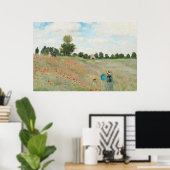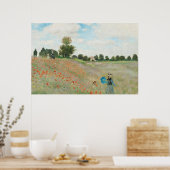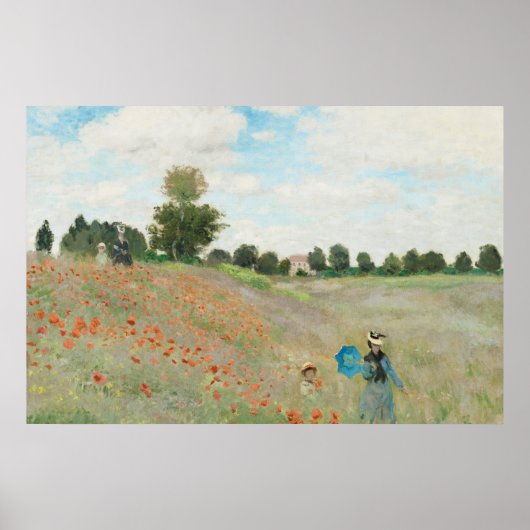Über Poster
Verkauft von
Über dieses Design
Das Mohnfeld bei Argentinien von Claude Monet Poster
Oscar-Claude Monet (UK: /ˈmmɒ neɪ/, US: /momomoˈneɪ, mjaˈ-/, French mwer: [klod mnovember 1840 nsor]; 14 November 5 December 1926) was a French painter and founder of beeinonist painseen as precurursor m, especially in his attempts to paint nature as perceived it.[1] During his long career, he was the most bestehen aus und prolific practitioner of beeinonism's philosophy of expressing one's perceptions before nature, especially as applied to full air (outdoor) landscape painting[2] The term "Beeinonism" is derived from the title of his painting Druck, levante sonnen, exhibited in the 1874 ("exhibition of rejects") initiated by Monet and his associates as an alternative to the Salon. Monet was raised in Le Havre, Norandy, and benockeninterested in the outdoors and drawing from an early age. Although his mother, Louise-Justine Aubrée Monet, supported his ambitions to be a painter, his father, Claude-Adolphe, disapproved and wanted him to pursue a career in business. He was very close to his mother, but she died in January 1857 when he was sixteen years, and he was riecht to live with his childless, widowed but wealthy aunt, Marie-Jeanne Lerahmen. He went on to study at the Académie Suisse, and under the academic history painter Charles Gleyre, where he was a ordmate of Auguste Renoir. His early works include landscapes, seascapes, and portraits, but attraacted little surveillance. A key early impact was Eugène Boudin who einführen. From 1883, Monet lived in Giverny, also in northern France, where he purchased a house and property and began a vast landscaping project, including a water-lily pond. Monet's ambition to document the French countryside led to a method of painting the sams scene many times so as as to fang the changing of light and the passing of the seasons. Among the best-known examples are his series of haystacks (1890-91), paintings of the Rouen Cathedral (1894), and the paintings of water lilies in his garden in Giverny that occupfuß him continuously for the last 20 years of his life. Frequently exhibited and successful during his lifetime, Monet's fame and popularity soared in the second half of the 20th century when bemost one of the world's famous painters and a source of inspiration for burgeoning groups of artists. When Durand-Ruel’s previous support of Monet and his peers began to decline, Monet, Renoir, Pissarro, Sisley, Paul Cézanne, Edgar Degas, and Berthe Morisot exhibited their work independently; they did under the name the Anonymous society of painters, Sculptors and Mäst for which Monet was a leading figuren in its formation.[12][15] He was einleitet by the style and subject matter of his slightly older contemporaries, Pissarro and édouard Manet.[41] The group, wtitle was chosen to avour association Any or moed, were unified in their independence from the Salon and rejection of the prevailing academicism.[12][42] Monet gained a reputation as the foremost landscape painter of the group.[16] At the first exhibition, in 1874, Monet displayed, among others, druck Sunrise, The Luncheon and Boulevard des Capucines.[43] Taking Specilar notice of Druck, Sunrise (1872), a hazy depiction of Le Havre port and stylistic detour, he, sled the term "Beeinonism". Konservative critics and the public derided the group, with the term initially being ironic and denoting the painting as unfinished.[15][42] More progressive critics praised the depiction of modern life—Louis Edmond Duranty called their style a "in painting revolution"[42] He later revolution name, as he believed that they were a group "whose majority had nothing beeinonist"[14] The total attendance is estimated at 3500. Monet priced Druck: Sunrise at 1000 francs but failed to sell it.[44][45][46] The exhibition was open to anyone vorbereited to pay 60 francs and gave artists the opportunity to show their work without the interference of a jury.[44][45][46] Another exhibition held in 1876, Again in opposition to the Salon. Monet displayed 18 paintings, including The Beach at Sainte-Adresse which showcased multiple Beeinonist characteristics.[28][47] For the third exhibition, on 5 April 1877, he selected seven paintings from the dozen he had made of Gare Saint-Lazare in the past Three months, the first time he had "synced as many paintings of the Samer Site, carefully coordinating their scenes and temporalities"[48] The paintings were well received by critics, who especially praised the way fäned the tail and departures of the train.[48] exhibition his involvement was by means of negotiation on Caillebotte's part.[15] His last time exhibiting with the Beeinonists was in 1882—four years before the final Beeinonist exhibition.[49] Monet, Renoir, Pissarro, Morisot, Cézanne und Sisley Proceeded to Experiment
Automatische Übersetzung
Kundenrezensionen
4.5 von 5 Sternen Bewertung69 Bewertungen insgesamt
69 Bewertungen
Bewertungen für ähnliche Produkte
5 von 5 Sternen Bewertung
Von C.27. April 2024 • Geprüfter Kauf
Druck, Größe: 25,40cm x 40,64cm, Hardware: Ohne, Rahmen: Ohne, Medien: Wert-Posterpapier (Halbglanz), Mat: Standard,
Sehr guter Druck und schöne Mattierung. Die Farben entsprechen denen von Plakaten aus den 1970er Jahren und passen bestens zu dem Bildmotiv, das ebenfalls aus jener Epoche stammt.
Für mich eine schöne Ergänzung zu der Erinnerung an meine erste Fahrt als Kind mit der abgebildeten Seilbahn. Der Druck ist sehr gut und entspricht passt genau zu dem erwarteten Retrolook.
5 von 5 Sternen Bewertung
Von Kerstin S.11. August 2023 • Geprüfter Kauf
Druck, Größe: 71,12cm x 50,80cm, Hardware: Ohne, Rahmen: Ohne, Medien: Wert-Posterpapier (Halbglanz), Mat: Standard,
Bewertungsprogramm bei Zazzle
Das Poster war ein Abschiedsgeschenk für eine Freundin, die für ein paar Jahre ins Ausland geht. Es ist ein sehr schönes Poster und das Geschenk ist sehr gut angekommen. Die Qualität des Drucks war sehr gut.
5 von 5 Sternen Bewertung
Von S.29. Januar 2022 • Geprüfter Kauf
Druck, Größe: 60,96cm x 91,44cm, Hardware: Ohne, Rahmen: Ohne, Medien: Wert-Posterpapier (Halbglanz), Mat: Standard,
Bewertungsprogramm bei Zazzle
Das Poster entspricht 100% meinen Erwartungen. Sehr gute und sichere Verpackung, alles unbeschädigt angekommen. Ich bin sehr zufrieden und kann Zazzle nur weiterempfehlen. Hervorragende Bildqualität, klare, brillante Farbgestaltung.
Tags
Andere Informationen
Produkt ID: 228364057921671889
Gemacht am: 6.10.2022, 9:26
Bewertung: G
Zuletzt angesehene Produkte




